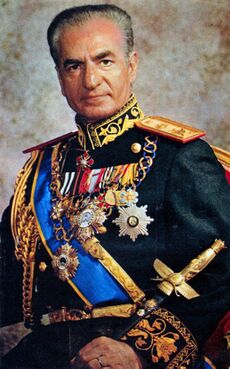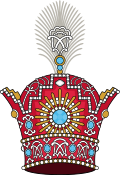شاه
شاه (بالفارسية والكردية) هي كلمة بمعنى ملك، تطلق على الحاكم في إيران.
. . . . . . . . . . . . . . . . . . . . . . . . . . . . . . . . . . . . . . . . . . . . . . . . . . . . . . . . . . . . . . . . . . . . . . . . . . . . . . . . . . . . . . . . . . . . . . . . . . . . . . . . . . . . . . . . . . . . . . . . . . . . . . . . . . . . . . . . . . . . . . . . . . . . . . . . . . . . . . . . . . . . . . . .
أصل الكلمة
The word descends from Old Persian xšāyaθiya "king", which used to be considered a borrowing from Median,[1] as it was compared to Avestan xšaϑra-, "power" and "command", corresponding to Sanskrit (Old Indic) kṣatra- (same meaning), from which kṣatriya-, "warrior", is derived. Most recently, the form xšāyaθiya has been analyzed as a genuine, inherited Persian formation with the meaning 'pertaining to reigning, ruling'. This formation with the "origin" suffix -iya is derived from a deverbal abstract noun *xšāy-aθa- 'rule, ruling, Herrschaft', from the (Old Persian) verb xšāy- 'to rule, reign'.[2] The full, Old Persian title of the Achaemenid rulers of the First Persian Empire was Xšāyaθiya Xšāyaθiyānām or (Modern Persian) Šāhe Šāhān, "King of Kings"[3] or "Emperor". This title has ancient Near Eastern or Mesopotamian precedents. The earliest attestation of such a title dates back to the Middle Assyrian period as šar šarrāni, in reference to the Assyrian ruler Tukulti-Ninurta I (1243–1207 BC).
التاريخ

Šāh, or Šāhanšāh (King of Kings) to use the full-length term, was the title of the Persian emperors. It includes rulers of the first Persian Empire, the Achaemenid dynasty, who unified Persia in the sixth century BC, and created a vast intercontinental empire, as well as rulers of succeeding dynasties throughout history until the twentieth century and the Imperial House of Pahlavi.
While in Western sources the Ottoman monarch is most often referred to as a Sultan, in Ottoman territory he was most often referred to as Padishah and several used the title Shah in their tughras. Their male offspring received the title of Şehzade, or prince (literally, "offspring of the Shah", from Persian shahzadeh).
The full title of the Achaemenid rulers was Xšāyaθiya Xšāyaθiyānām, literally "King of Kings" in Old Persian, corresponding to Middle Persian Šāhān Šāh, and Modern Persian شاهنشاه (Šāhanšāh).[4][5] In Greek, this phrase was translated as βασιλεὺς τῶν βασιλέων (basileus tōn basiléōn), "King of Kings", equivalent to "Emperor". Both terms were often shortened to their roots shah and basileus.
أساليب مخاطبة أخرى
- Shahbanu (Persian شهبانو, Šahbānū): Persian term using the word shah and the Persian suffix -banu ("lady"): Empress, in modern times, the official title of Empress Farah Pahlavi.
- Shahpur (Persian شاهپور Šāhpu:r) also been derived from shah using the archaic Persian suffix -pur "son, male descendant", to address the Prince.
- Shahdokht (Persian شاهدخت Šāhdoxt) is also another term derived from shah using the Persian patronymic suffix -dokht "daughter, female descendant", to address the Princess of the imperial households.
- Shahzade (Persian شاهزاده Šāhzādeh): Persian termination for prince (lit; offspring of the Shah); used by Ottoman Turks in the form Şehzade.
- Malik al-muluk (Persian ملک الملوک) "king of kings", an Arabic title used by the Iranian Buyids, a Persianized form of the Abbasid amir al-umara
مصطلحات ذات صلة
- Satrap, the term in Western languages for a governor of a Persian province, is a distortion of xšaθrapāvan, literally "guardian of the realm", which derives from the word xšaθra, an Old Persian word meaning "realm, province" and related etymologically to shah.
- Maq'ad-i-Shah, (Persian مقعد شاه Maq'ad-i-Shah), the phrase from which the name of Mogadishu is believed to be derived, which means "seat of the Shah", a reflection of the city's early Persian influence.[6]
- The English word "check-mate" is in fact derived from "shah" (from Persian via Arabic, Latin and French). Related terms such as "chess" and "exchequer" likewise originate from the Persian word, their modern senses having developed from the original meaning of the king piece.[7]
انظر أيضاً
الهامش
- ^ An introduction to Old Persian (p. 149). Prods Oktor Skjærvø. Harvard University. 2003.
- ^ Schmitt, Rüdiger (2014). Wörterbuch der altpersischen Königsinschriften. Wiesbaden: Reichert Verlag. pp. 286–287. ISBN 9783954900176.
- ^ Old Persian. Appendices, Glossaries, Indices & Transcriptions. Prods Oktor Skjærvø. Harvard University. 2003.
- ^ D. N. MacKenzie. A Concise Pahlavi Dictionary. Routledge Curzon, 2005. ISBN 0-19-713559-5
- ^ M. Mo’in. An Intermediate Persian Dictionary. Six Volumes. Amir Kabir Publications, Teheran, 1992.
- ^ David D. Laitin, Said S. Samatar, Somalia: Nation in Search of a State, (Westview Press: 1987), p. 12.
- ^
 Chisholm, Hugh, ed. (1911). . دائرة المعارف البريطانية (eleventh ed.). Cambridge University Press.
Chisholm, Hugh, ed. (1911). . دائرة المعارف البريطانية (eleventh ed.). Cambridge University Press. {{cite encyclopedia}}: Cite has empty unknown parameter:|coauthors=(help)
وصلات خارجية
- مقالات المعرفة المحتوية على معلومات من دائرة المعارف البريطانية طبعة 1911
- Short description is different from Wikidata
- Missing redirects
- Articles containing فارسية-language text
- Articles containing Ancient Greek (to 1453)-language text
- Heads of state in Asia
- Royal titles
- ألقاب نبلاء
- Persian words and phrases
- Titles of national or ethnic leadership
- Ottoman titles
- Titles in Iran
- Titles in Azerbaijan
- Titles in Bangladesh
- Titles in Pakistan
- Government of the Sasanian Empire
- Government of the Parthian Empire
- حكام

